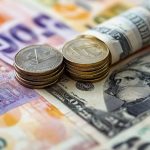In the early Asian session on Friday, gold prices remain flat around $2,455 as traders look for direction amid consolidation in the US Dollar. Investors are closely watching the preliminary release of the US Michigan Consumer Sentiment Index for August and data on Building Permits and Housing Starts. Despite positive employment and retail sales data from the US, traders still expect the Federal Reserve to start easing policy in September. The markets are pricing in a nearly 80% chance of a rate cut next month and anticipate a 200 basis points reduction in the next year, depending on incoming data. Encouragingly, US Retail Sales rose by 1.0% in July, surpassing expectations and boosting the USD. However, the geopolitical risks in the Middle East may help support gold prices as a safe-haven asset.
Gold has historically been a store of value and medium of exchange, and is now seen as a safe-haven asset during turbulent times. Beyond its use in jewelry, gold is also considered a hedge against inflation and depreciating currencies due to its independence from any specific issuer or government. Central banks are significant holders of gold, using it to support their currencies and diversify reserves to enhance economic and currency strength. In 2022, central banks added 1,136 tonnes of gold valued at around $70 billion to their reserves, the highest annual purchase on record. Emerging economies like China, India, and Turkey are actively increasing their gold holdings.
Gold has an inverse relationship with the US Dollar and US Treasuries, major reserve and safe-haven assets. When the dollar weakens, gold prices tend to rise, providing an opportunity for investors and central banks to diversify their assets during uncertain times. Gold also shows an inverse correlation with risk assets, as a rally in the stock market can weaken gold prices, while sell-offs in riskier markets tend to benefit the precious metal. Various factors can influence gold prices, including geopolitical instability, recession fears, interest rates, and the behavior of the US Dollar. In times of uncertainty, gold’s safe-haven status can lead to price surges, while higher interest rates can suppress its value.
The recent escalation of geopolitical risks in the Middle East, such as the conflict in Gaza resulting in numerous casualties, may provide some support for gold prices. Despite this, the strength of the US Dollar following positive economic data from the US, including retail sales and jobless claims, has weighed on the price of gold. Investors are closely monitoring upcoming economic indicators and the potential actions of the Federal Reserve in September. The uncertain global economic environment, combined with geopolitical tensions and central bank actions, will continue to influence gold prices in the coming weeks. As a traditional safe-haven asset, gold remains an attractive investment option for those seeking stability and protection against market volatility.









